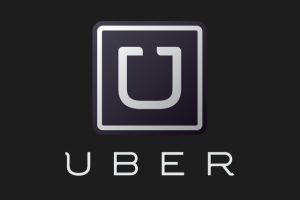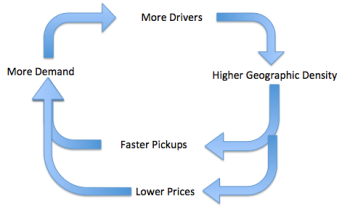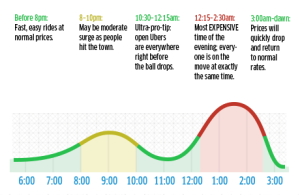 It is exciting to see products that change people’s behavior at the mass scale. Products like facebook, instagram, and whatsapp are undoubtedly some of the change leaders but people take time to appreciate these products. However, there are products that take our breath away the first time we use them. UBER is one such product that is inspirational for its design, purpose, and nearly flawless implementation. I am deeply influenced by UBER and end up discussing it invariably in most product related discussions with fellow friends. Before I dive into describing why I truly admire about UBER, let me share some experiences that helped me build the perspective.
It is exciting to see products that change people’s behavior at the mass scale. Products like facebook, instagram, and whatsapp are undoubtedly some of the change leaders but people take time to appreciate these products. However, there are products that take our breath away the first time we use them. UBER is one such product that is inspirational for its design, purpose, and nearly flawless implementation. I am deeply influenced by UBER and end up discussing it invariably in most product related discussions with fellow friends. Before I dive into describing why I truly admire about UBER, let me share some experiences that helped me build the perspective.
First Experience
In June 2014, I used UBER in Gurgaon (India) for the first time, primarily because it extended an opportunity to travel in high-end cars like BMW 7 series, which I could not afford otherwise. It was a premium experience; I loved to talk about it within my network, and observed how I opened up from being cost conscious to experience conscious customer. Multiple WhatsApp groups were abuzz with discussions every time someone used the service. The community around me, which I believed would find it expensive, proved me wrong. People were open to shell out a few extra bucks for the UBER experience. The zero barrier trial with the first-two free rides and word-of-mouth virality were driving people crazy. Entire experience from onboarding to payment was redefined and was incredibly seamless.
Second Experience
In August 2014, I relocated to California. At San Francisco Airport, I wanted to use UBER to drive down to Sunnyvale. Unfortunately, I did not have a US number activated, so I was forced to take a traditional taxi. I wondered why the hell do they not have a web interface or let alone a counter at SFO airport; it could drive so much business after all. I paid $127 to the taxi driver and later discovered that I overpaid at least $40 for not using UBER. This experience drove me crazy to try UBER even more. The first thing I wanted after having a local number activated was to use UBER for my routine travel between home and NASA campus.
Regular Experiences
Until I bought my car, I used UBER for over 30 trips between Sunnyvale and NASA Research center and conversed with almost every driver out of curiosity to discover how do they feel post UBER era. Taxi drivers ranged from 25-year-old professionals upto 60 years old retired men and women. What I discovered was truly transformational. Particularly, a recent immigrant from east coast, who joined a real-estate agency, used UBER to familiarize herself with the new geography in addition to making a few extra bucks. An Asian retired person admired the sophisticated and yet easy-to-use technology interface that empowered him to make upto $2500 a month easily, a sum that helped him fulfill his family needs in the growing cost structures of bay area. Every driver had a unique and exciting story to share. I could closely feel the inclusive social impact that UBER was driving.
Macro View
At the macro level, it is a clean unification of three heterogeneous infrastructures
- Physical Layer – Drivers and Personal cars
- Data Layer – Advanced Geographical Information System
- Application Layer – Intelligent dispatching software system
The resulting infrastructure is the classic two-sided marketplace of car drivers (the producers) and the end consumers with a trustworthy distribution network that is really hard to replicate.
Product Design
From the design standpoint, I think following decisions were crucial to deliver the optimal and consistent experience
- Native smartphone application not HTML5 web application. It is easy to fall trap for the opportunity loss due to SEO driven traffic, but web could actually not deliver the connected and engaging experience that native application can. It is a hard choice but an immaculate decision to deliver superlative experience.
- Leverage existing physical infrastructure in developed countries, but create own infrastructure (UBER leased a fleet in India) in developing countries. This is a very capital-intensive decision but went long way in ensuring the consistency in experience.
- Most applications ignore the importance of last-mile information delivery. UBER does a fantastic job of providing visibility into the last-mile dispatching of car in real-time. This is the disruptive UX and certainly requires heavy engineering investment. The only place you witness such an experience is in the international flights.
- While every transactional business was trying to bring the payments experience down to a single click, it was probably the first time I experienced a zero click payment interface. Having worked closely with payments industry, I can vouch that UBER’s payment experience is absolutely stunning. I believe that the absence of the explicit act-of-payment will become the de-facto standard going forward.
Growth View
UBER’s success depends not only upon how soon can it attract both sides on its platform, the drivers and the travelers but also on the levels of participation of both the sides. A higher participation from drivers is useful only if it results in higher availability, and consequently, lower waiting time for travelers. Similarly, a higher participation from passengers is useful to drivers only when it means lower down time and, potentially, the ability to charge higher prices, thanks to Uber’s much-maligned surge pricing. (Surge pricing increases rates as demand overtakes supply)

Each driver is unique and different and therefore is the weakest link in spoiling the entire experience for the customers. Therefore, driver’s onboarding is crucial to enforcing compliance, uniformity, and customer delight. A few challenges I can think of are
- Background verification of each driver to establish trustworthiness
- Training of each driver to deliver the same level of experience
- Compliance enforcement at each node for every transaction
- Quick turnaround for onboarding
- Sophisticated commission computation and disbursal system
- Transaction analysis to detect patterns for unfair practices
- Fraud detection and resolution mechanisms
I have not signed up as a driver but understand that the driver’s onboarding process is entirely automated, seamless, and quick. Considering the complexity and current scale, I think the driver’s onboarding process is designed remarkably, which in my opinion is very crucial for leveraging the network effect.
From the customer onboarding standpoint it is important to lower down the barrier for trial and hence adoption. Assuming that the product is well designed and delivers aspirational experience, customers actually end up spreading the word-of-mouth leading to huge virality. Four important metrics that are crucial to understand the user acquisition story are
- Virality coefficient
- Virality Decay
- Virality Cycle Time
I wouldn’t be surprised to know if the virality coefficient ranges from 0.5 to 0.7. Two schemes in my opinion would lead to such a high value
- First ride free – This lowers the barriers for new users to try the service and talk about it.
- Referral Bonus to both the parties – Both the referrer and referee receive $20 bonus credits on the first ride ensuring that each person invites at least one person.
Considering the virality decay is 50% overall, The Virality Coefficient above 0.5 would lead to a hockey stick curve growth, which looks pretty likely. My wild guess is that the decay would be more than 80% within 2-3 days for infrequent travelers.
The virality cycle time would be really low because the probability of newly acquired customer experiencing the service immediately would be low. I would imagine that the average cycle time could range between 5-10 days.
Renting a taxi is transactional in nature. As the need is fulfilled, users tend to move out of engagement loop. But the length of the transaction in this particular case is large, which works in favor as the customer spends more time thinking about the service. Traditional taxi renting experience clearly needed improvement both on customer onboarding and offloading. UBER’s entire transaction experience flow is single purpose and designed to engage customers extensively.
Customer Focus
UBER somehow makes you believe that it is in a constant pursuit of driving the travel costs down to zero eventually some day. The launch of UBERX signaled the effort and the launch of UBERPOOL was even more convincing. From the user retention standpoint, it gained the trust of busy professionals who demand great user experience along with a dependable service.
On the New Year eve, I received an email around how prices will be shot up around the peak load time. This proactive pursuit of informing the users goes a long way in winning the trust further.

Suggestions
I’d recommend two features that I believe would go a long way in retaining the customers
- Onboarding duration accuracy – As soon as the nearest taxi driver accepts the request, the application flashes the approximate duration (t1) within which the taxi is expected to reach the customer. But that duration is not reliable as the net duration (t2) taken by the taxi driver could be X times higher than it first flashed on the screen. Because of this I don’t trust UBER in critical situations. Let’s say the application also flashes a static timer that computes the net duration to onboard the customer, and the driver is incentivized for reaching earlier than approximate expected time, it will significantly enhance overall onboarding duration accuracy. For the delay of more than 2 minutes over expected time, the customer should be compensated suitably.
- People Discovery – It would be great to get the application social. If I can discover who else travels the same route within the half-mile of both the source and the destination, I may be willing to work around my travel time to leverage the UBER POOL benefits. This service can lock the users from going to any other similar service provider and shall hugely contribute to retention of existing customers.